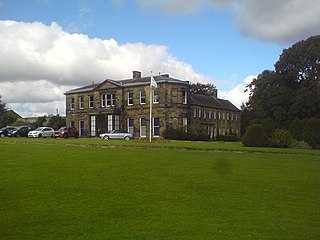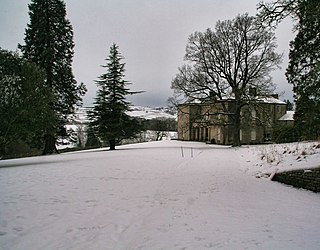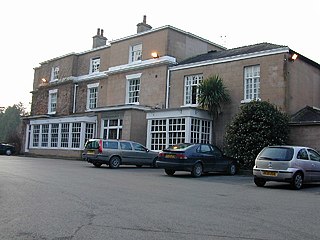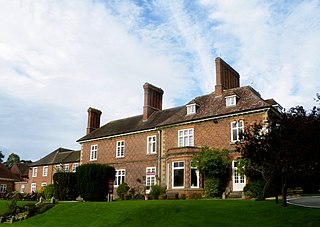
Farnley Hall is a stately home in Farnley, west Leeds, West Yorkshire, England. It is a grade II listed building. It was built in Elizabethan times by the Danbys. The manor is recorded in the 1086 Domesday Book as Fernelei, so it is probable that this house was a replacement for earlier medieval structures.
Robert Needham, 2nd Viscount Kilmorey was an English Royalist and supporter of Charles I during the English Civil War.
Sir Piers Dutton was the lord of the manor of Dutton from 1527 until his death. He was involved in the closing of Norton Abbey during the Dissolution of the Monasteries in 1536. He started rebuilding Dutton Hall in 1539.

Sir Thomas Joseph de Trafford, 1st Baronet, was a member of a prominent family of English Roman Catholics. He served as commander of the Manchester and Salford Yeomanry at the time of the Peterloo Massacre. He was born at Croston Hall near Chorley, Lancashire, on 22 March 1778, son of John Trafford and Elizabeth Tempest, and was christened Thomas Joseph Trafford.

Markeaton Park is a large public park located in Markeaton, Derby, 207 acres in size. It attracts one million visitors a year, making it one of the most visited parks in the East Midlands. Markeaton Park is an important part of Derby history, which was sold to the Mundy family in 1516. The Mundy family gave Markeaton Park to Derby City Council in the early 20th century, who now provide facilities and events throughout the year.

Eggleston Hall is a privately owned 19th-century English country house in Eggleston, Teesdale, County Durham. It is a Grade II* listed building.
Richard Standish was an English politician who sat in the House of Commons in 1659 and 1660. He was a colonel in the Parliamentarian army in the English Civil War.

Hartford Manor is a former country house in the village of Hartford, Cheshire, England. Its age is uncertain; it was said to have been re-fronted in about 1820 for John Marshall, but the core of the building is earlier. It has since been altered and extended. During the 20th century the building was used an office. It one time it was used by North West Gas; as of 2011 it is the office of Holidaybreak. The house is constructed in yellow ashlar stone, and it has a hipped slated roof. Its front is symmetrical with two storeys and five bays. The central bay is slightly bowed, and contains a portico with two Doric columns and a flat entablature. It is recorded in the National Heritage List for England as a designated Grade II listed building. It is now used for office accommodation.

Hoole Hall is a former country house located to the north of Chester, Cheshire, England. It originated as a small house in about 1760, built for the Rev John Baldwin. After Rev Baldwin's death in 1793, the house passed to his eldest son, Thomas Baldwin, who then sold the house and surrounding land in 1800.

Middlewich Manor is a former manor house in Middlewich, Cheshire, England. It was originally constructed in brick in about 1800, and it was encased in ashlar in about 1840, when the porch was also built The bay windows were added in the 1870s. As of 2011, it is a residential care home. The house is constructed in yellow ashlar and is in two storeys. On its entrance front is a porch supported by four fluted Ionic columns. Along the top of the porch is a frieze and a cornice. On each side of the porch are two-storey canted bay windows. Between the stories is a band of Greek keys. A parapet runs along the top of the house, behind which is a low-pitched roof. On the garden front there are sash windows and a canted two-storey bay window to the right, and a wing with a stone oriel window and a pyramidal slated roof to the left. There is more decoration with bands of Greek keys on this front. The house is recorded in the National Heritage List for England as a designated Grade II listed building.

Rowton Hall Hotel is a historic stately home, now run as a hotel in Rowton, Cheshire, England. The hall was originally built in the 14th century and was rebuilt in 1779 in the Georgian style. The Battle of Rowton Heath took place in the grounds in 1643. It contains the oak-panelled Langdale Restaurant.
Sir John Holcroft of Holcroft Hall, Culcheth, was a soldier, politician, and landowner of the Tudor period. He was returned twice as a member of the English parliament for Lancashire.

Soughton Hall is a Grade II* listed country house hotel in Sychdyn, Flintshire, Wales. Notable guests that have stayed include Luciano Pavarotti, Michael Jackson and King Juan Carlos I of Spain. William John Bankes inherited Soughton Hall in the 1815.

Thomas Savage, 1st Viscount Savage, 2nd Baronet, was an English peer and courtier in the reign of Charles I.

Sandywell Park is an Jacobean Georgian manor house, five miles east of Cheltenham in Gloucestershire, England. Built in 1704 by Henry Brett, it was extended a few times over the 18th century. In the mid-eighteenth century the Sandywell Park estate acquired the Whittington Court building. Sandywell Park is today a Grade II* listed building.

The National Communities Resource Centre (NCRC) is a British charity which was set up in 1991 to offer support and training to residents in low-income areas. It runs courses for tenants and community groups from its premises near Chester. Since 2020 it has been part of Regenda Group, a company which provides and operates affordable housing.

Lympstone Manor in Exmouth, England, is a building of historical significance and is Grade II listed on the English Heritage Register. It was mainly built in the 1760s around an older building which had been used as a farmhouse. At this time the owner was Charles Baring, a wealthy banker who had just been married. It was the residence of many notable people for the next two centuries. Today it is a hotel, restaurant and vineyard. The house has never held the Manorship of Lymstone, which instead has traditionally been associated with Nutwell Court.

Albrighton Hall near Shrewsbury, Shropshire, is a house which is Grade II* listed on the National Heritage List for England. It was built in 1630 for the Ireland family and remained in this family for the next five generations until 1804. It was then the home of several notable people until 1953. In the 1990s it was converted into a hotel.

Horsforth Hall Park is a large community park in Horsforth, West Yorkshire, England, approximately six miles from Leeds city centre.

Yeldersley Hall is a building of historical significance in Ashbourne, Derbyshire, England and is listed on the English Heritage Register. It was built in about 1800 by a wealthy landowner and was the residence of many notable people over the next two centuries. Today it is a venue for special events, particularly weddings.



















